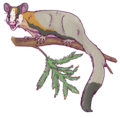Patagomaia
| Patagomaia Temporal range: Late Cretaceous,
| |
|---|---|

| |
| holotype remains of Patagomaia chainko | |
| Scientific classification | |
| Domain: | Eukaryota |
| Kingdom: | Animalia |
| Phylum: | Chordata |
| Class: | Mammalia |
| Subclass: | Theria |
| Genus: | †Patagomaia |
| Species: | †P. chainko
|
| Binomial name | |
| †Patagomaia chainko Chimento et al., 2024
| |
Patagomaia is an extinct mammal of uncertain affinities, originally described as a therian mammal, from the Maastrichtian Chorrillo Formation of Argentina. It is the largest Mesozoic mammal yet known, with weight estimates of around 14 kilograms (31 lb).[1] The type species is P. chainko.
Description
[edit]Patagomaia chainko is known from the distal end of the left ulna, two fragments of the preacetabular wing of the left ilium, acetabular region of the left hemipelvis, fragment of the ischial blade, proximal end of the right femur; distal end of the left femur, proximal end of the left tibia, and other indeterminate bone fragments. It is estimated to weigh over 14 kilograms (31 lb), narrowly beating the previous Mesozoic mammal contender, Repenomamus giganticus.[1][2]
Classification
[edit]Patagomaia chainko is tentatively described as a therian mammal. However, it does not match any early Cenozoic South American therian group.[1] Püschel et al. (2024) subsequently argued that Patagomaia might be a large gondwanatherian, possibly synonymous with Magallanodon,[3] but Chimento, Agnolín & Novas (2024) did not consider their arguments to be conclusive.[4]
Palaeoecology
[edit]Patagomaia chainko was found alongside the monotreme Patagorhynchus, the meridiolestidan Orretherium, the gondwanathere Magallanodon and several dinosaurs.[1]
Implications
[edit]Alongside Malagasy gondwanatheres like Adalatherium and Vintana and South American mesungulatid meridiolestidans, Patagomaia chainko provides evidence that Late Cretaceous Gondwanan mammal faunas tended to achieve larger sizes than their northern counterparts.[1]
References
[edit]- ^ a b c d e Chimento, Nicolás R.; Agnolín, Federico L.; García-Marsà, Jordi; Manabe, Makoto; Tsuihiji, Takanobu; Novas, Fernando E. (February 3, 2024). "A large therian mammal from the Late Cretaceous of South America". Scientific Reports. 14 (1): 2854. Bibcode:2024NatSR..14.2854C. doi:10.1038/s41598-024-53156-3. PMC 10838296. PMID 38310138.
- ^ "Larger-than-expected prehistoric mammal species uncovered in Patagonia". phys.org.
- ^ Püschel, Hans P.; Martinelli, Agustín G.; Soto-Acuña, Sergio; Vargas, Alexander O. (2024). "Patagomaia could be a gondwanatherian". Scientific Reports. 14 (1). 28632. doi:10.1038/s41598-024-78400-8. PMC 11576905.
- ^ Chimento, Nicolás R.; Agnolín, Federico L.; Novas, Fernando E. (2024). "Reply to: "Patagomaia could be a gondwanatherian"". Scientific Reports. 14 (1). 28634. doi:10.1038/s41598-024-78401-7. PMC 11577045.




